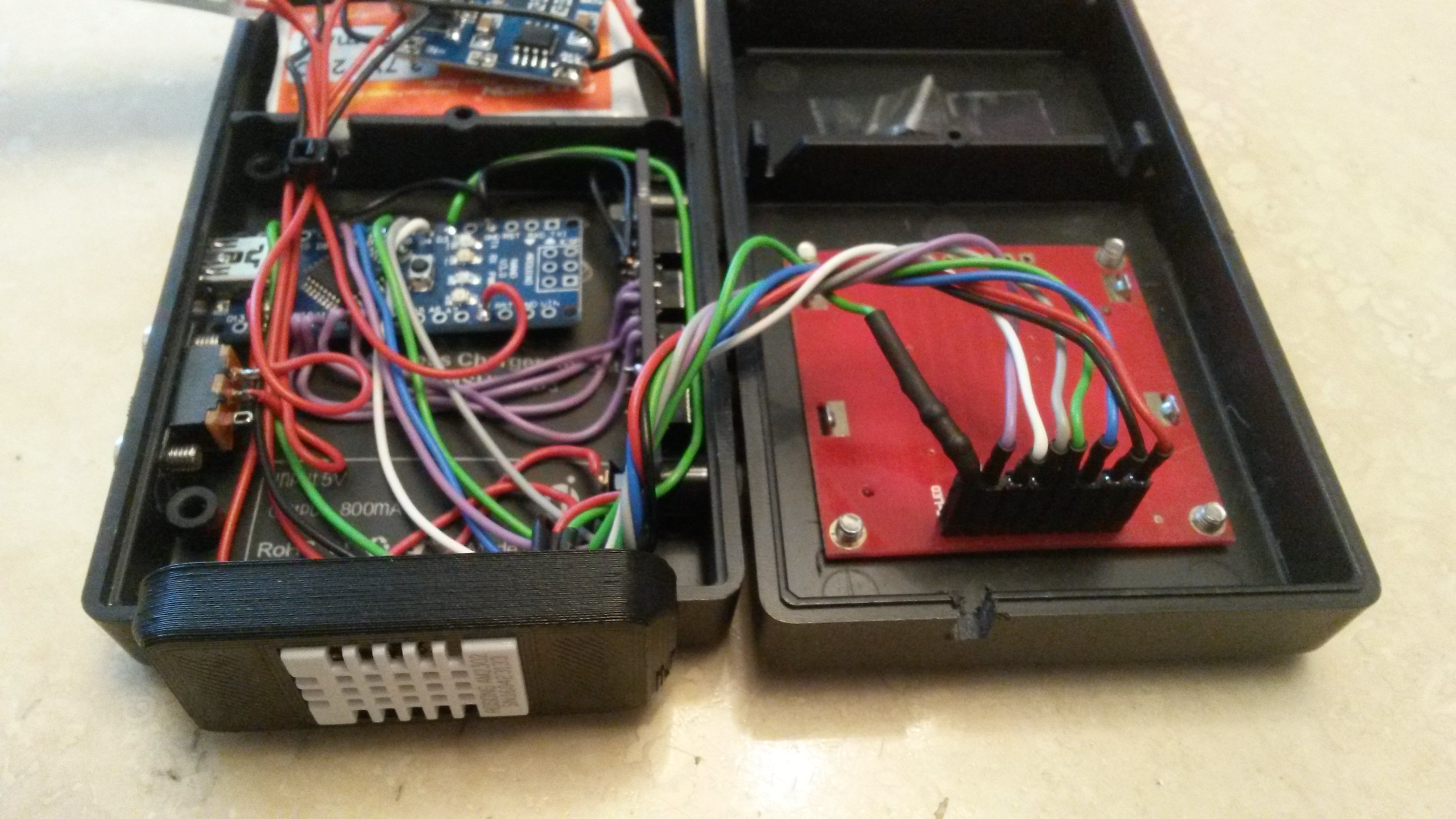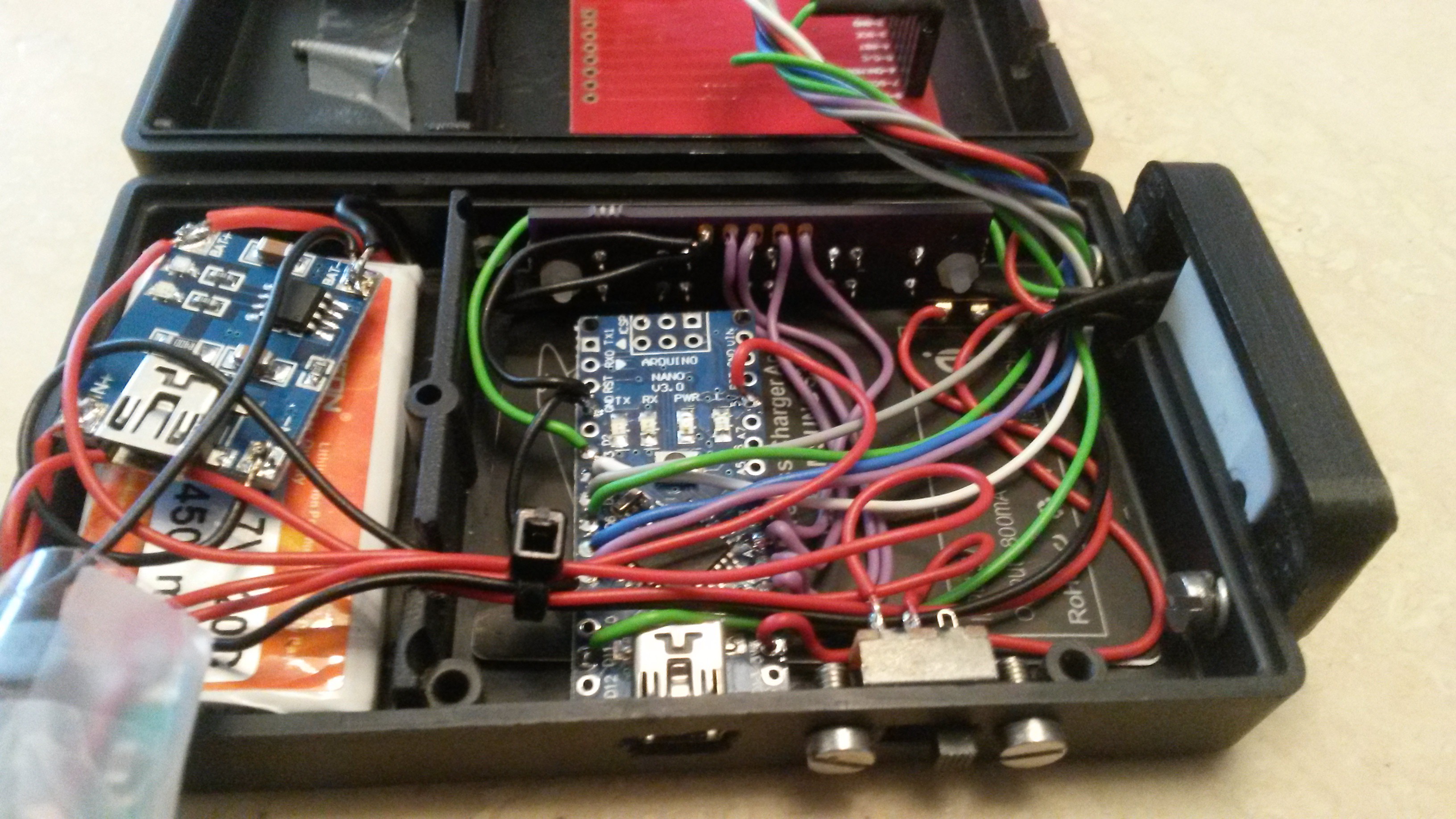In order to test some more things out, a small, LiPo operated sensing box was finished today. The last days it was lacking the LiPo which was delivered yesterday.
Nothing special and not very well built, but it´s intended to:
- Carry it around and check environmental parameters.
- Compare values with actual cloud base height.
- Testing wireless charging.
- Try out some programming issues with push buttons, display, menu,....
The box is a simple polymer case (Kemo G01B), contanining an Arduino Nano, 1s-450mAh LiPo, Qi-Charging receiver coil for S3, TP4056 charger, Nokia 5110 display, DC-DC-Boost converter and an AM2302 humidity sensor. Of course, some small parts like a sliding switch, screws, a 330 Ohm resistor for the display and a 3d-printed holder for the AM2302.
Actually, while using it powered by USB cable, the slow AM2302 was the reason for the SHT21 iterations...
 It works quite OK using u8glib and currently there´s nothing more implemented than reading out the humidity, temperature and displaying the calculated dew point, heat index and ceiling height. It´s really nothing special but already makes fun carrying it around checking local conditions. At the moment, it only can be switched on and it immediately starts displaying the values. --> "KISS".
It works quite OK using u8glib and currently there´s nothing more implemented than reading out the humidity, temperature and displaying the calculated dew point, heat index and ceiling height. It´s really nothing special but already makes fun carrying it around checking local conditions. At the moment, it only can be switched on and it immediately starts displaying the values. --> "KISS".
Wireless charging seems to work. I had to change the charging current of the TP4056 by soldering in a 2.2 kOhm resistor (0603 size) instead of its default resistor. Now it charges the LiPo with approx. 400-500 mA.
Here are some more images from the inside.


And here´s the code I´m using at the moment. No temperature case distinctions yet.
#include "U8glib.h"
#include "DHT.h"
#include "math.h"
#define DHTPIN 3
#define DHTTYPE DHT22
#define backlight_pin 11
DHT dht(DHTPIN, DHTTYPE);
U8GLIB_PCD8544 u8g(8, 4, 7, 5, 6); // CLK=8, DIN=4, CE=7, DC=5, RST=6
//###############################################################################################################################
void setup(void) {
analogWrite(backlight_pin, 10); /* Set the Backlight intensity */
dht.begin();
u8g.setRot180();
}
//###############################################################################################################################
void loop(void) {
u8g.firstPage();
do {
draw();
} while( u8g.nextPage() );
delay(300); // Delay before accessing AM2302
}
//################################################################################################################################
void draw(void) {
u8g.setFont(u8g_font_profont11); // select font
u8g.drawStr(0, 7, "Temp: "); // put string of display at position X, Y
u8g.drawStr(0, 17, "rH: ");
u8g.drawStr(0, 27, "HI: ");
u8g.drawStr(0, 37, "Dew: ");
u8g.setPrintPos(45, 7); // set position
u8g.print(dht.readTemperature(), 1); // display temperature from DHT22
u8g.drawStr(73, 7, "C ");
u8g.setPrintPos(45, 17);
u8g.print(dht.readHumidity(), 1); // display humidity from DHT22
u8g.drawStr(73, 17, "% ");
u8g.setPrintPos(45, 27);
u8g.print(dht.computeHeatIndex(dht.readTemperature(), dht.readHumidity(), false), 1); // display humidity from DHT11
u8g.drawStr(73, 27, "C ");
// 243.12*((log10(dht.readHumidity())-2.0)/0.4343+(17.62*dht.readTemperature())/(243.12+dht.readTemperature()))/(17.62-((log10(dht.readHumidity())-2.0)/0.4343+(17.62*dht.readTemperature())/(243.12+dht.readTemperature())))
u8g.setPrintPos(45, 37);
u8g.print(243.12*((log10(dht.readHumidity())-2.0)/0.4343+(17.62*dht.readTemperature())/(243.12+dht.readTemperature()))/(17.62-((log10(dht.readHumidity())-2.0)/0.4343+(17.62*dht.readTemperature())/(243.12+dht.readTemperature()))), 1); // display humidity from DHT11
u8g.drawStr(73, 37, "C ");
u8g.setPrintPos(35, 47);
u8g.print(125*(dht.readTemperature()-(243.12*((log10(dht.readHumidity())-2.0)/0.4343+(17.62*dht.readTemperature())/(243.12+dht.readTemperature()))/(17.62-((log10(dht.readHumidity())-2.0)/0.4343+(17.62*dht.readTemperature())/(243.12+dht.readTemperature()))))), 0); // display humidity from DHT11
u8g.drawStr(73, 47, "m ");
}Conclusion & further to-do:
- Much fun to use, although nothing special!
- Wireless charging using the Qi receiver is easy and useful.
- AM2303 is slow.
- Implement LiPo voltage readout !
- Implement push buttons for menu etc.
- Correlate real ceiling heights with calculated ones.
- Search for display alternatives (slightly bigger, sun readable, low power consumption).
- Design new case for use with SHT21.
- ...
 TheotherMike
TheotherMike
Discussions
Become a Hackaday.io Member
Create an account to leave a comment. Already have an account? Log In.